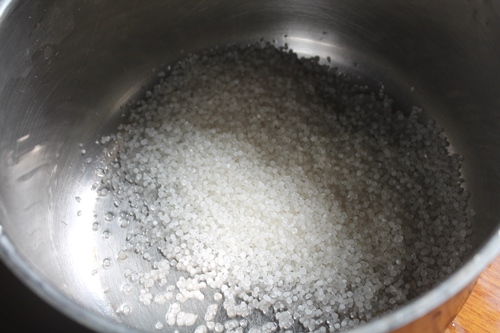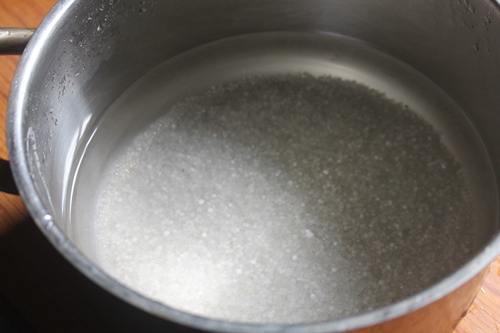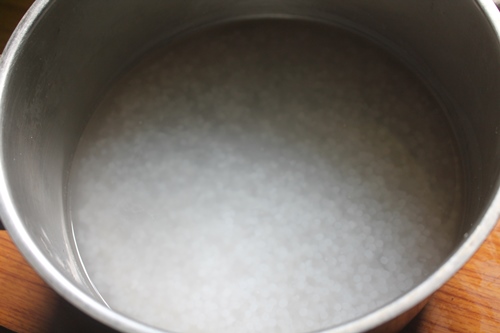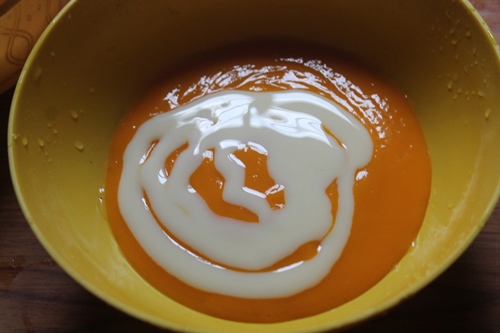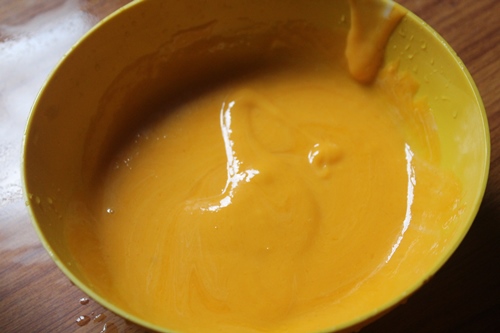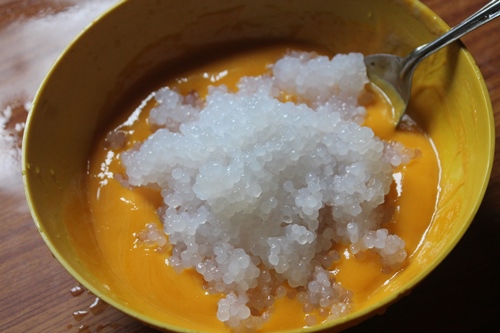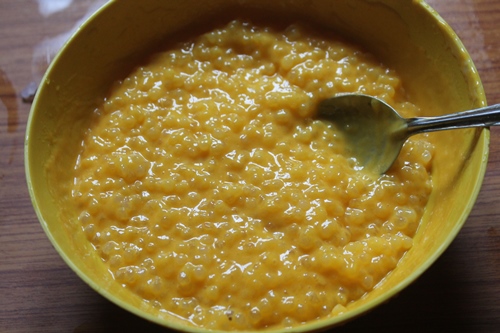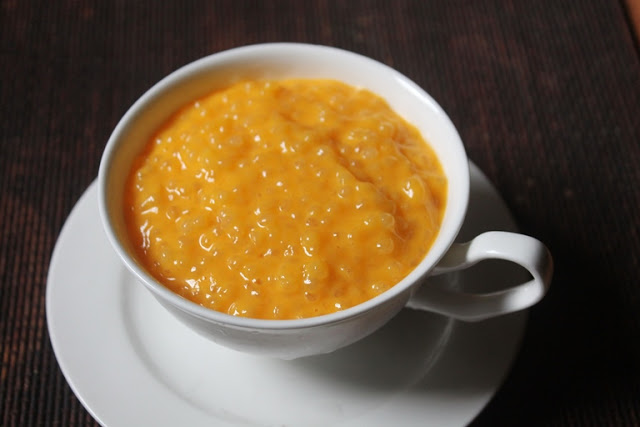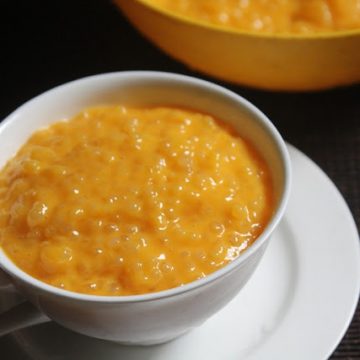Mango Sago Recipe, is a creamy and refreshing dessert made with chewy sago pearls (sabudana), sweet mangoes, and rich condensed milk, often served chilled. Popular across many Asian cuisines and especially loved during mango season, this dessert strikes the perfect balance between fruity sweetness and velvety texture.
Whether offered as prasadham or served as a light dessert after meals, Mango Sago feels like a bowl of sunshine — soothing, nostalgic, and soulfully delicious.


Mango Sago
This Mango Sago recipe is something I recently started making as a Thursday prasadham for Sai Baba, during my fasting routine. Last week, it was sheera, and this week I felt inspired to make something seasonal and soothing and mango sago was the first thing that came to mind. Since it’s mango season, it just felt right to share this simple, soul-satisfying dish.
Jump to:
What is Mango Sago?
Mango Sago Recipe, is a creamy and refreshing dessert made with chewy sago pearls (sabudana), sweet mango pulp, and rich condensed milk, often served chilled. Popular across many Asian cuisines and especially loved during mango season, this dessert strikes the perfect balance between fruity sweetness and velvety texture.
The soft, jelly-like sago pearls soak up the tropical mango flavor, making every spoonful smooth, slightly chewy, and utterly satisfying. It’s a comforting dish that’s incredibly simple to prepare, needs only a few ingredients, and is perfect for hot summer days. Check my Dessert Soup which is perfect for summer.
About Mango Sago
It’s one of those recipes that looks fancy but is incredibly easy. You just need three main components — mango pulp, cooked sago, and condensed milk. And once combined and chilled, it turns into a dreamy dessert you’ll keep going back to. What I love most is how the textures mix with each other — the chew of the sago, the silkiness of the mango, and the richness of the condensed milk. For More South Indian Mango Sago Kheer.
Another beautiful thing about this recipe is how adaptable it is. You can keep it super minimal, like I’ve done here, or build on it with toppings like chopped mangoes, nuts, or even a scoop of vanilla ice cream. Whether you serve it as a prasadham, festive sweet, or a cool treat for guests, Mango Sago never disappoints.
Similar Dessert Recipes
Palm Fruit Drink
Rice Sago Kheer
Badam Kheer
Wheat Rava Payasam
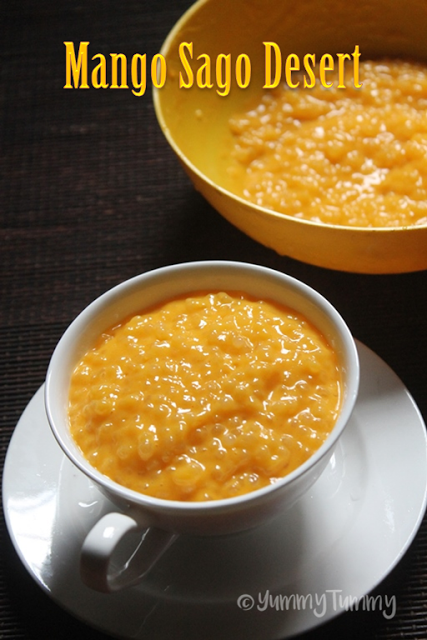

Why This Recipe Works
This Mango Sago recipe is a beautiful blend of simplicity and indulgence. It’s made using just a handful of ingredients that are usually easy to find — chewy sago pearls, sweet mango pulp, and thick, creamy condensed milk. Nothing too fancy, but when combined, the flavors are rich and incredibly satisfying.
The entire process takes about 25 minutes from start to finish, which means you don’t need to spend hours in the kitchen to whip up a refreshing dessert. Even better, it doesn’t require any advanced techniques or special tools, making it ideal for beginners or busy cooks. I have shared more mango recipes with the combination of sago and mangoes. Check my mango sago kheer
Why I Love This Recipe – Personally, this recipe is special because it has become part of a weekly ritual for me. I fast every Thursday and make offerings to Sai Baba — and preparing something like this gives me a moment of peace and joy. Mango Sago in particular feels like a soft reward after a long day of fasting. My family loves it too! It’s light yet indulgent, and always reminds us of summer holidays. I remember eating mangoes straight from the fridge as a child, juice dripping down my arms — and this dessert captures that memory in a more grown-up, desserty way. It’s creamy, cool, and never too sweet.
It’s naturally gluten-free, which is great if you’re looking for allergy-friendly sweets. And if you’re someone who loves a bit of creativity in the kitchen, it’s incredibly versatile — you can swap condensed milk for coconut milk, throw in bits of fresh mango or jelly cubes, or even serve it in pretty dessert glasses with mint leaves for an elevated presentation.
Mango Sago Ingredients
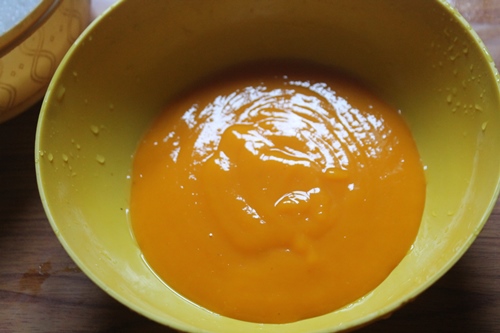

Sago (sabudana) – These tiny white pearls are made from tapioca starch and might look plain at first, but once cooked, they become translucent and soft with just the right amount of chewiness. They’re the soul of this dessert, giving it that signature sago texture we all love.
Water – This is used to cook the sago. Don’t skimp on the water! Using plenty ensures the sago pearls stay separate and don’t stick together. Once they turn glassy and soft, rinse them in cold water to stop the cooking and keep the texture perfect.
Mango pulp – You can go with canned Alphonso mango pulp for that classic, vibrant yellow hue and a deep, sweet mango flavor. But if you’ve got fresh, ripe mangoes at home, even better! Just blend them until smooth. It makes the dessert feel even more homemade and nostalgic.
Sweetened condensed milk – This is where all the creaminess and sweetness comes from. It thickens the base, binds everything together, and eliminates the need for extra sugar. If you want the dessert a bit less rich, feel free to use a mix of condensed milk and regular milk or coconut milk.
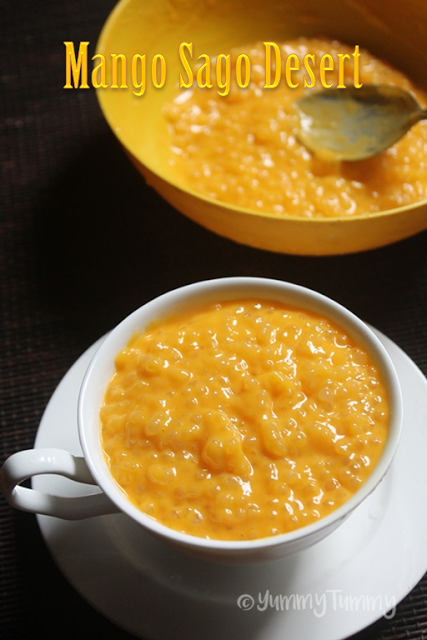

Hacks
No Mango Pulp? No problem! If you don’t have ready-made mango pulp, just peel and chop 2 large, ripe mangoes (like Banganapalli or Alphonso), blend them smooth with a teaspoon of sugar, and use that instead. It tastes just as good — sometimes even better when the mangoes are super sweet and in season!
Want to keep it light and less sweet? Try using half the quantity of condensed milk and balance it with thick coconut milk. It’ll still be creamy but with a lighter, more tropical flavor. This tweak also makes it slightly healthier and adds a lovely coconut note to the dessert.
For perfectly chewy sago: Soak the sago pearls in water for about 15–20 minutes before boiling. This ensures they cook evenly and turn soft all the way through. It also helps prevent clumping, a common problem if sago is boiled directly.
Make it richer and more indulgent: A small splash of full cream milk or even evaporated milk can take this dessert to another level. It gives the sago a silky-smooth finish and adds extra body to the dish, especially if you’re planning to serve it for guests.
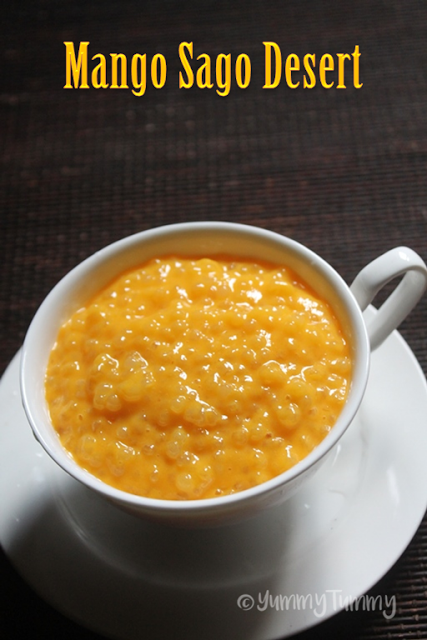

How to Make Mango Sago (Stepwise Pictures)
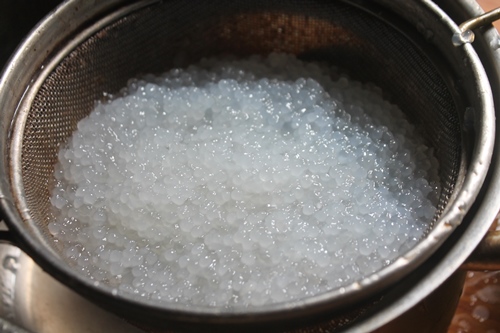  |
| drain it and wash this in cold water. Set aside |
Expert Tips
Don’t overcook the sago: Watch closely while boiling — as soon as most pearls turn translucent with just a tiny white dot in the center, it’s time to stop. Overcooked sago turns mushy and loses its chewy charm.
Choose the right mangoes: If you’re making your own pulp, go for mangoes that are naturally sweet and non-fibrous — Alphonso and Banganapalli are excellent choices for their bright color and intense flavor.
Serving & Storage
Store your mango sago in an airtight container and refrigerate. It stays fresh for up to 2–3 days. Just give it a quick stir before serving as the sago might settle a bit.
Serving Suggestions: Serve it cold, preferably in small dessert bowls or fancy glasses. For that extra wow factor, top it off with fresh mango cubes, mint leaves for a refreshing touch, crushed pistachios or roasted cashews for a nutty crunch and you can even drizzle a little coconut milk or saffron-infused milk just before serving!
FAQ
Q. Can I use coconut milk instead of condensed milk?
Yes, absolutely! It brings a lovely tropical flavor and makes the dessert lighter. You might want to add some sugar or jaggery syrup to balance the sweetness.
Q. My sago turned sticky and clumpy — what went wrong?
It may have been overcooked or not rinsed properly. To fix it: rinse in cold water and gently separate the pearls using a fork or your fingers.
Q. Can I make this dessert ahead of time?
Yes, and in fact, you should! Mango Sago tastes even better after being chilled for a few hours as the flavors meld together beautifully.
Variations
Mango Coconut Sago: For a lighter, more tropical version, replace half (or even all) of the condensed milk with thick coconut milk. It brings a subtle nuttiness and pairs beautifully with mango’s natural sweetness. This variation is especially great during summer and for those who enjoy mildly sweet desserts.
Layered Mango Sago Delight: In a transparent dessert glass, start with a layer of mango sago, add a handful of diced ripe mangoes, then spoon in some colorful jelly cubes. Repeat the layers for a visually stunning and texturally exciting dessert — perfect for parties or special occasions.
Vegan-Friendly Twist: To make it 100% vegan, skip the condensed milk and go with coconut cream, almond milk, or any plant-based milk you love. Sweeten it with jaggery syrup, maple syrup, or dates puree for a rich, earthy flavor that complements the mango beautifully. This version is dairy-free, yet super creamy and satisfying.
Fun Add-Ins for Extra Texture & Flavor:
Want to add a little fun and flair? Try mixing in any of these to elevate the dessert experience:
– Soaked sabja seeds (basil seeds): They add a refreshing, Falooda-like texture and cooling effect.
– Chia seeds: A healthy and fiber-rich addition that blends well with the creamy base.
– Fruit jelly cubes: Colorful and chewy, they bring a playful bite to every spoonful.
– Canned lychees or longan: Their floral, sweet flavor pairs beautifully with mango and adds an exotic touch.
More Yummy Mango Recipes
📖 Recipe Card
Mango Sago Recipe (Mango Sago)
Servings: 4 servings
Calories: 422kcal
Instructions
Pre-Prep: Start by rinsing the sago lightly and keeping it aside. You don’t have to soak them, but doing so for 10–15 minutes can help cook them more evenly. Also, if using fresh mangoes, peel, chop, and puree them now.
Cooking the Sago: Boil 3 cups of water in a large pan. Once boiling, add the sago pearls and cook them on medium flame until they become translucent. Stir occasionally to prevent sticking. This should take about 10–12 minutes. Once done, strain the sago and rinse under cold water to remove excess starch and stop further cooking.
Making the Mango Sauce: In a mixing bowl, combine 2 cups of mango pulp and 1 cup of condensed milk. Whisk until smooth and creamy. If your mango pulp is a bit thick, feel free to thin it down with a tablespoon or two of milk or water.
Combining Everything: Add the cooled, drained sago pearls to the mango-condensed milk mixture. Stir gently to combine everything. Taste and adjust sweetness if needed.
Chilling: Transfer the mixture into serving bowls or a large container and refrigerate it for at least 2–4 hours. This helps the flavors come together and gives that chilled texture.
Video


Notes
Choose the right mangoes: If you’re making your own pulp, go for mangoes that are naturally sweet and non-fibrous — Alphonso and Banganapalli are excellent choices for their bright color and intense flavor.
Storage & Serving
Store your mango sago in an airtight container and refrigerate. It stays fresh for up to 2–3 days. Just give it a quick stir before serving as the sago might settle a bit.
Serve it cold, preferably in small dessert bowls or fancy glasses. For that extra wow factor, top it off with fresh mango cubes, mint leaves for a refreshing touch, crushed pistachios or roasted cashews for a nutty crunch and you can even drizzle a little coconut milk or saffron-infused milk just before serving!
Nutrition
Serving: 1servings | Calories: 422kcal | Carbohydrates: 84g | Protein: 7g | Fat: 7g | Saturated Fat: 4g | Polyunsaturated Fat: 0.3g | Monounsaturated Fat: 2g | Cholesterol: 26mg | Sodium: 159mg | Potassium: 284mg | Fiber: 2g | Sugar: 66g | Vitamin A: 3036IU | Vitamin C: 19mg | Calcium: 234mg | Iron: 15mg
If you have any questions not covered in this post and if you need help, leave me a comment or mail me @[email protected] and I’ll help as soon as I can.
Follow me on Instagram, Facebook,Pinterest ,Youtube for more Yummy Tummy inspiration.
IF YOU MAKE THIS RECIPE OR ANYTHING FROM YUMMY TUMMY, MAKE SURE TO POST IT AND TAG ME SO I CAN SEE ALL OF YOUR CREATIONS!! #YUMMYTUMMYAARTHI AND @YUMMYTUMMYAARTHI ON INSTAGRAM!
More Payasam (Kheer) Recipes
–>

